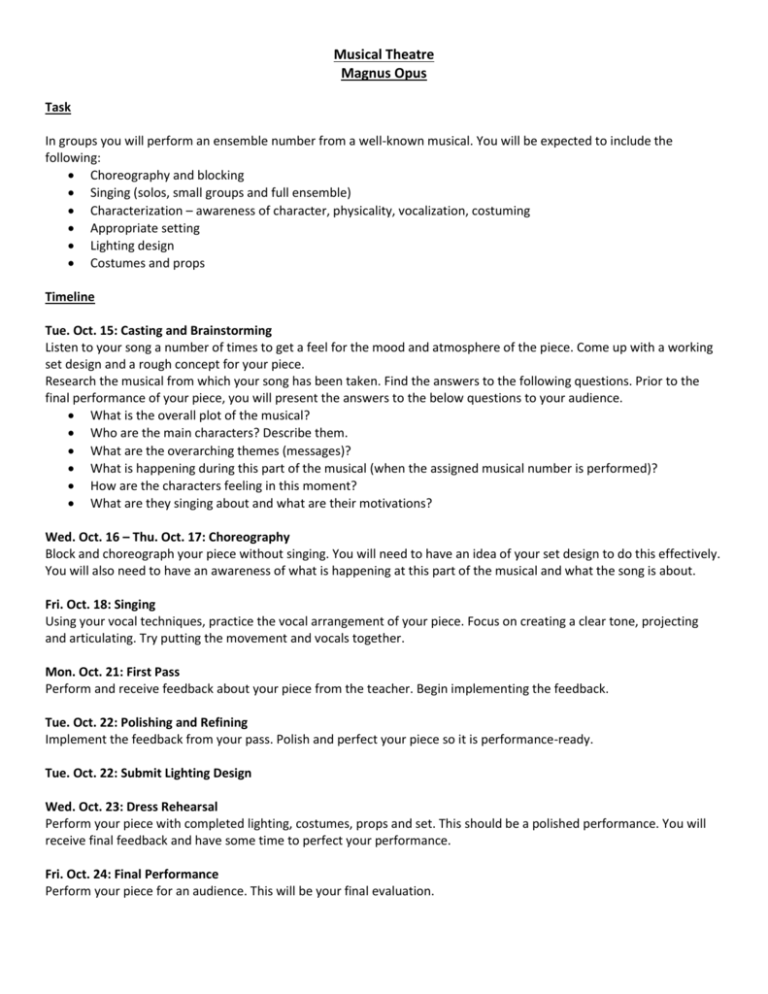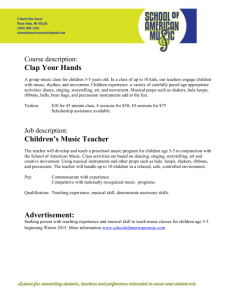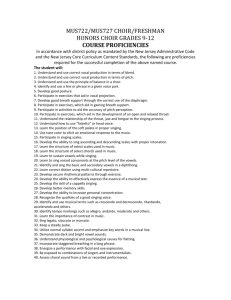Frat Girl 2/Store Owner
advertisement

Musical Theatre Magnus Opus Task In groups you will perform an ensemble number from a well-known musical. You will be expected to include the following: Choreography and blocking Singing (solos, small groups and full ensemble) Characterization – awareness of character, physicality, vocalization, costuming Appropriate setting Lighting design Costumes and props Timeline Tue. Oct. 15: Casting and Brainstorming Listen to your song a number of times to get a feel for the mood and atmosphere of the piece. Come up with a working set design and a rough concept for your piece. Research the musical from which your song has been taken. Find the answers to the following questions. Prior to the final performance of your piece, you will present the answers to the below questions to your audience. What is the overall plot of the musical? Who are the main characters? Describe them. What are the overarching themes (messages)? What is happening during this part of the musical (when the assigned musical number is performed)? How are the characters feeling in this moment? What are they singing about and what are their motivations? Wed. Oct. 16 – Thu. Oct. 17: Choreography Block and choreograph your piece without singing. You will need to have an idea of your set design to do this effectively. You will also need to have an awareness of what is happening at this part of the musical and what the song is about. Fri. Oct. 18: Singing Using your vocal techniques, practice the vocal arrangement of your piece. Focus on creating a clear tone, projecting and articulating. Try putting the movement and vocals together. Mon. Oct. 21: First Pass Perform and receive feedback about your piece from the teacher. Begin implementing the feedback. Tue. Oct. 22: Polishing and Refining Implement the feedback from your pass. Polish and perfect your piece so it is performance-ready. Tue. Oct. 22: Submit Lighting Design Wed. Oct. 23: Dress Rehearsal Perform your piece with completed lighting, costumes, props and set. This should be a polished performance. You will receive final feedback and have some time to perfect your performance. Fri. Oct. 24: Final Performance Perform your piece for an audience. This will be your final evaluation. Musical Theatre Performance Rubric Focus and Energy /5 (App.) Props and Set /5 (Comm.) Movement, Physicality and Choreography /10 (App.) Singing and Vocal Technique /10 (App.) Characterization and Costumes /10 (Comm.) Criteria Level 1 Costumes is ineffective in communicating character Characterization is unconvincing; student has made no attempt to learn or play the character effectively Character’s motivations and objectives are unclear Student does not project Student’s articulation is weak and the audience has difficulty understanding Pace and rhythm are off from musical timing throughout most of the performance and hinder characterization Student makes little attempt to use proper singing techniques such as diaphragmatic breathing and open resonating cavities Student’s vocal choices hinder characterization The vocal choices are unmotivated or non-existent Blocking is unmotivated and ineffective Student demonstrates little awareness of how to use the stage Choreography is boring Student struggles to move in synchronization with the music and other actors Masking is prominent Student has failed to make physical choices to aid characterization Set is not functional (too complex or too simple); mood and setting are unclear Props are not functional, hinder character, and get in the way Student lacks commitment to character and performance Student is unfocused throughout the majority of the performance Student lacks energy and thus delivers a weak performance COMMENTS: Level 2 Costume somewhat communicates character; parts of the costume are incomplete or inconsistent Characterization is somewhat consistent; some choices are ineffective or unconvincing Character’s motivations and objectives are clear during some parts of the performance Student’s projection is inconsistent and not always appropriate for the character Student sometimes articulates, but the audience can understand only half the words Pace and rhythm is inconsistent with the musical timing and may not help to communicate character Student sometimes attempts to use proper singing techniques such as diaphragmatic breathing and open resonating cavities Student’s vocal choices somewhat help to communicate character The vocal choices are unmotivated; may not have made specific choices Blocking somewhat unmotivated; strictly functional Student demonstrates some awareness of how to use the stage Choreography adds some interest Student moves in synchronization with the music and other actors some of the time; struggles with staying on the beat Some masking is evident Student’s physical choices communicate character inconsistently Set somewhat functional (may be too complex or too simple); setting and mood may be unclear Props are somewhat functional, may help to communicate character and bring meaning to the lyrics and situation; may be used too much or too little; may hinder scene Student’s commitment to character and performance is inconsistent Student breaks focus two or more times throughout the performance Student’s energy is low and thus delivers a mediocre performance. Level 3 Costume clearly communicates character and adds some dimension to the overall performance; some elements are inconsistent Characterization is clear and consistent throughout Character’s motivations and objectives are clear Level 4 Effective costume, which clearly communicates character and adds dimension to the overall performance Characterization is clear, effective and consistent throughout Character’s motivations and objectives are clear Student’s projection is good, but inconsistent throughout entire performance; sometimes not appropriate for character Student articulates effectively and the audience can understand most words Pace and rhythm matches musical timing throughout most of the song and helps to communicate character Student attempts to use proper singing techniques such as diaphragmatic breathing and open resonating cavities Student’s vocal choices communicate character The vocal choices are somewhat motivated Student’s projection is consistent and appropriate throughout entire performance Student articulates effectively and the audience can understand every word Pace and rhythm matches musical timing and helps to communicate character Student uses proper singing techniques such as diaphragmatic breathing and open resonating cavities Student’s vocal choices communicate character clearly The vocal choices are motivated and help to improve overall effect Blocking is sufficient; may not be effective or maximize space Student demonstrates an awareness of how to use the stage Choreography is entertaining Student moves in synchronization with the music and other actors most of the time Minimal masking is evident Student’s physical choices communicate character clearly and effectively throughout most of the performance Blocking is effective and motivated Student demonstrates an awareness of how to effectively use the stage Choreography is entertaining and impressive Student moves in synchronization with the music and other actors No masking is evident Student’s physical choices communicate character clearly and effectively Set is mostly functional and somewhat helps to set the scene and mood Props are functional, help to communicate character and bring meaning to the lyrics and situation; may be used too much or too little Set is functional and helps to set the scene and mood Props are functional, help to communicate character and bring meaning to the lyrics and situation Student is committed to character and performance Student breaks focus once throughout the entire performance Student somewhat energized and channels their energy into delivering an effective and entertaining performance. Student is entirely committed to character and performance Student does not break focus throughout the entire performance Student is energized and channels their energy into delivering an effective and entertaining performance. CAST LIST “There are no small parts, only small actors.” OMIGOD, YOU GUYS GEE, OFFICER KRUPKE Legally Blonde West Side Story Margot - Kylie Action - Grant Serena - Tayler Baby John - Mike Pilar - Jade Diesel - James Frat Girl 1/Sale Woman - Kim A-Rab - Perry Frat Girl 2/Store Owner - Laura Kate - Morgan Elle - Chanelle







